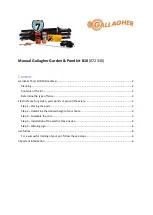
7.7- Repeating the test
The cycle previously described will be carried out six times with the same sample of oil.
Between the cycles it will be necessary to wait to the disappearance of the gas bubbles that
have possibly been produced, either waiting for 5 minutes, or selecting the stirring function.
7.8- Stopping the equipment
When the equipment is not used, turn the key to the stop position (“O”).
7.9- Evaluating the results
Once we have finished all the cycles (six), we will write down the following data to do the report:
- Sample
identification
- The value of each one of the six disruptive voltages (kV)
- The average value of the six tests (kV)
- The type of electrodes we have used and the distance between them
- The frequency of the test voltage (50 Hz)
- The oil’s temperature
- If we have used the stirrer function or not
In order to determine if the state of the oil is correct or not, we will see if the average value of the
six tests is within the right operation range that indicates the manufacturer of the oil. If the value
is outside this range we will have to adopt the opportune measures to diminish the degree of
contamination of the oil.
If you are not able to find another value, an habitually used criterion (but not indicated by the
standard) is to consider as good the oils that have an average value of dielectric strenght higher
than 80 kV/cm (remember that we can obtain the dielectric strenght multiplying the disruptive
voltage by 4, in the case of following the IEC-156 standard).
8. MAINTENANCE
The electrodes will be examined frequently to observe punctures or other deteriorations and must
be maintained in good state or to replace them when it is observed that they are deteriorated (for
example punctures by effect of discharges).
The new electrodes, the pricked electrodes, and those that suitably have been kept during a
considerable time must be cleaned of the following form:
- Disassemble the electrodes of the cell using the provided Allen spanner, very carefully,
avoiding to touch directly with the fingers, very important at the end of the electrodes, in which
the electrical arc takes place.
- Clean all the surfaces with an appropriate volatile dissolvent and let it evaporate.
- Polish with an abrasive powder (for instance, red fine dust to polish) or with an abrasive paper
or cloth (for instance, very fine polishing cloth or canvas).

































